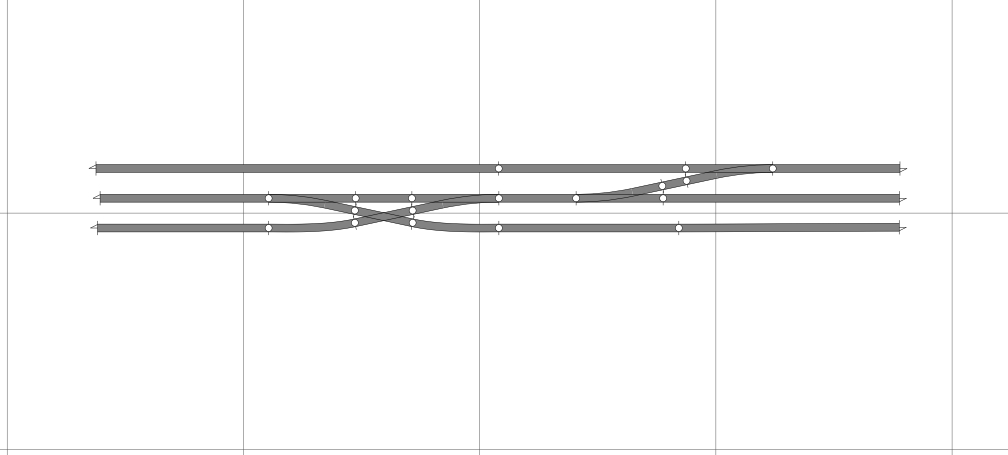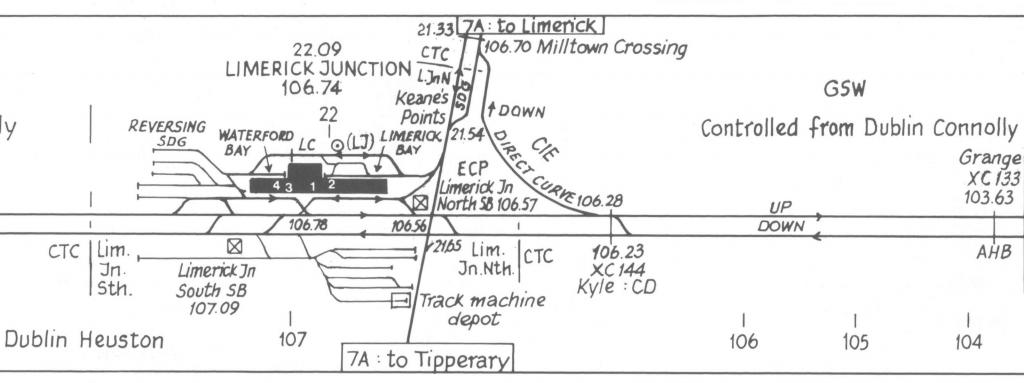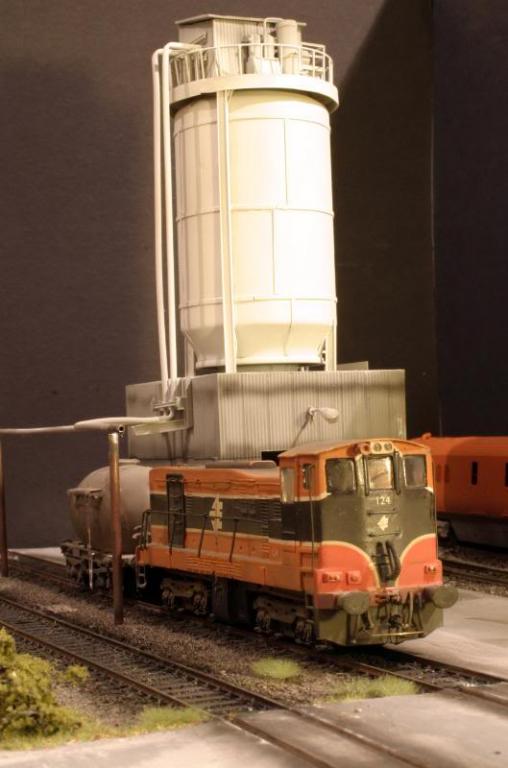-
Posts
1,037 -
Joined
-
Last visited
-
Days Won
5
Content Type
Profiles
Forums
Events
Gallery
Blogs
Store
Community Map
Everything posted by josefstadt
-

Generator cars for irish coaching stock - specifically HLV
josefstadt replied to Junctionmad's question in Questions & Answers
The period you are looking at, mid-1970s to mid-1980s, was one of transition - the Mk IId AC stock and the BR vans had arrived in the early 1970s, the programme of converting orthodox (non-AC) stock to TL was progressing steadily and the 4-wheel and 6-wheel vans were being phased out. By November 1978 all the 4-wheel luggage vans had gone as had most of the 4-wheel SHVs - only 11 remaining in traffic. These, along with the four 6-wheel SHVs were by that time mainly employed in the Dublin suburban area. Also by this time all the Cravens, the main line Park Royals, the last series of Laminates (1497-1503), some catering vehicles and about 50% of the 19xx Brake Standard types had been converted to TL (excluding a number of vehicles which had already been withdrawn). The ‘Dutch’ vans had all been converted to TL by November 1978, while the 32xx GSVs/Brake Std GSVs were introduced between 1977 and 1980. On the other hand, the suburban Park Royals and the bulk of the Laminates (1429-96) retained their batteries and axle-driven dynamos. The bogie luggage vans (2548-91) also retained their batteries and axle-driven dynamos. By the end of 1980 all the 4-wheel vans were gone, while a start had been made on the conversion of further Park Royals and Laminates to TL. And, of course, by the end of the period you are looking at the Mk III stock had arrived leading to a further culling of earlier stock. So, I suggest that for Limerick Junction throughout the period in question, mid-1970s to mid-1980s, main line services would have generally been formed by either AC stock or TL fitted Cravens/Park Royals/Laminates operating with bogie GSVs or Brake Standard GSVs. Friday only services would have been composed of a variety of TL and non-TL stock carefully marshalled so that the TL vehicles were all able to be powered by the GSV. Pre-1977 there would have been 4-wheel or 6-wheel SHVs on the Limerick-Limerick Jct and Limerick-Waterford trains during the winter season. After 1977 the 4-wheel/6-wheel vans would, as BSGSV has shown, have been replaced by 32xx type GSVs, possibly operating with non-TL stock. At a later date the 32xx vans would themselves have been replaced by Dutch vans or BR vans as these were displaced from other duties. A trawl through the IRRS journal might throw up images of trains in the LJ area during the period you are interested in, or I'm sure that there would be people there who might be able to give you details of train formations. -

Generator cars for irish coaching stock - specifically HLV
josefstadt replied to Junctionmad's question in Questions & Answers
The BR vans were delivered to CIÉ as GSV's. As you say they were equipped with a single 2000 lb/hour Spanner boiler and a diesel generator set provided the power for the running of the boiler. The earlier heating luggage vans, including the Dutch vans, were Steam vans only and had no electric generating capacity. Power for the operation of the boilers in these vans was provided by batteries charged by axle-driven dynamos. The BR vans were delivered in January 1972 and in April of that year, during ESB power cuts, they proved to be a great asset to the company when they were placed at strategic locations around the Dublin area to generate electric current which was used to keep signalling systems and track circuiting operating. -
Nice pics Noel. Loco could do with a bit of weathering though, doesn't look realistic! Send her to Newry!
-
According to The Wanderer: 'Sadly due to operational issues between Limerick City of Culture 2014, Iarnrod Eireann & the RPSI. 461 wasn't used to haul the Grandmother Giant into Limerick'. I wonder what happened.
-

CIE Compartment Cars - What type of coaches?
josefstadt replied to Noel's question in Questions & Answers
Noel, all side-corridor compartment coaches were Bredins. The Park Royals, Laminates, Cravens etc were all centre-corridor open coaches. The only compartment stock to enter service after the introduction of the Park Royals was a series of 8 composites built in 1961/62 which had three 6-seat first class compartments and a 28-seat open saloon for standard class passengers. After that time the only compartment coaches which entered traffic were a number of rebuilt coaches which had originally been compartment stock - for example the 3201-12 series Brake Standard GSVs, introduced 1977, which were rebuilds from compartment stock in the 1339-50 and 1351-55 series. -

CIE Compartment Cars - What type of coaches?
josefstadt replied to Noel's question in Questions & Answers
Oh, I've wished that so many times. I went on a two week rambler all around the CIÉ system back in 1971, but as a secondary school student could only afford the ticket and two rolls of film (24 exp) for the trip. Such a shame - so much to photograph but so little film. Now, if I'd had a digital camera ............. I don't know if ttc will thank you for that , but maybe he knows someone who could enlighten us! -
Could you use Peco Code 75? It would seem that a fair representation of the scissors layout could be achieved using this track:
-

CIE Compartment Cars - What type of coaches?
josefstadt replied to Noel's question in Questions & Answers
Junctionmad, the sequence for standard class coaches was 'Bredins', then Park Royals, then Laminates and then Cravens. -

CIE Compartment Cars - What type of coaches?
josefstadt replied to Noel's question in Questions & Answers
The Limerick-Ballina services had indeed ceased on 3 April 1976. So during the late 70s / early 80s it would have been the branch train that you were on. -
All my sympathies to his family and friends. A sad loss to them and to the wider railway enthusiast community.
-

CIE Compartment Cars - What type of coaches?
josefstadt replied to Noel's question in Questions & Answers
There is no doubt that the photo was taken on the branch, but the question is what srevice was photographed. If you scroll down to the first comment under the photo's caption you will see that part of Loose Coupled's contribution includes: '... 121s were the staple diet on the Ballina road and despite how attractive 127 looks here with her ex Limerick passenger ...' (my emphasis). So it would seem that 1904 and 1442 (both opens) without van were on the branch train (Claremorris-Ballina), while the photographed set (including a side-corridor compartment coach and an open coach) with a van was on the Limerick to Ballina service. You could have travelled on this set between Claremorris and Ballina and, if it were during the summer season, the open coach might have been replaced with a brake / standard, thereby giving the impression of two coaches without a van.. -

CIE Compartment Cars - What type of coaches?
josefstadt replied to Noel's question in Questions & Answers
Because neither of the two coaches was a brake/standard, or a brake/first, a van would have been needed. And, because a brake van was needed then it would have been, outside the summer season, a steam heating van. As mentioned above the normal vehicles for the Ballina branch train were 1904 and 1442. Both of these were fitted with storage heaters and therefore could be used without a heating van, the requirement for a brake van being fulfilled by brake/standard 1904. It is possible, as has been suggested above, that the train in the photo was not the Ballina branch train but was instead the Ballina-Limerick train. -

Limerick Junction track layout/ signalling plan 1975-85
josefstadt replied to Junctionmad's question in Questions & Answers
Junctionmad, in the Mar 1976 in your post both 36 and 39 signals are small sized semaphore signals (as was common practice) reading into the 'Pocket' loop. In the first pic in Snapper's post #54 they are both shunt signals. Snapper do you know when the photos you posted were taken? Given the presence of hi-viz vest in one of the pics I'd guess post-1976. It would be interesting to know if the signals were changed from semaphores to shunt signals as this would seem to indicate a downgrading of the loop. -

Limerick Junction track layout/ signalling plan 1975-85
josefstadt replied to Junctionmad's question in Questions & Answers
The three colours are green, yellow and red. White aspects are only used on shunt signals. On the diagram the green is indicated by a vertical line on the circle, yellow by a diagonal line and red is normally represented by a horizontal line. The aspect normally shown is represented by a double line, e.g. if a signal normally displays a red aspect then there would be a double horizontal line. However, in the above diagram it woul appear that the aspects normally displayed is coloured in. So, on signals 12 and 15 the dark circle was, I'd suggest, in reality coloured red and on the Auto signal (bottom left) the dark circle was yellow as it would have been a distant signal for P15. -

Limerick Junction track layout/ signalling plan 1975-85
josefstadt replied to Junctionmad's question in Questions & Answers
As Snapper says, the arrangement at the Limerick end of the Direct Curve was to prove sufficient signaling overlap / protection so that a train from Dublin could be signaled onto the direct curve at the same time a train from Limerick was signaled either into Limerick Junction or towards Waterford. The overlap / protection was provided by the headshunt on the Limerick side of Milltown level crossing. The pocket loop was to provide a passing loop on the Limerick - Waterford route without trains having to go into Limerick Jct itself. It also enabled loco-hauled trains coming off the Waterford line and heading for the Cork direction, or vice versa, to run round. For example beet trains between Wellington Bridge and Mallow. -
Strange that the didn't put the full EVN on thr loco sides at the same time.
-

Limerick Junction track layout/ signalling plan 1975-85
josefstadt replied to Junctionmad's question in Questions & Answers
Junctionmad, sorry that I missed noticing that the Limerick end of the layout was missing (I was scanning Limerick Jct from the Dublin-Cork pages). Here is the scan from the Limerick-Waterford pageswhich shows the missing piece: As BSGSV says, there was a subsidiary E.T.S. instrument in a hut at Milltown. A signalman would walk out to that location (about ¼-mile) to either hand up or collect the staff from a train using the Direct Curve. Having the subsidiary instrument at Milltown meant that the section between Milltown and Dromkeen would have been occupied for less time than if the staff had to be transported to/from Limerick Jct North cabin. -

CIE Compartment Cars - What type of coaches?
josefstadt replied to Noel's question in Questions & Answers
The first coach was a side corridor compartment coach, either one of the 1952-built series 2130-36 or the 1954-build series 2137-61. The second coach looks like one of the 1958-built open standards from the series 1449-96. -

CIE Compartment Cars - What type of coaches?
josefstadt replied to Noel's question in Questions & Answers
Noel, the coaches you remember travelling in were steel panelled coaches (i.e. steel panels on a timber frame, commonly referred to in the media as 'wooden bodied coaches') not laminates. The SSM coach you link to is a model of a GSR-built Bredin-designed composite class coach. The vehicles built by CIÉ up to the introduction of the Park Royals (i.e. 1339 - 1378) were based on these coaches and were sometimes referred to as 'Bredins', although the CIÉ design was a development of the GSR design, the main difference being n increase in the carriage length from 60' 0" to 61' 6". The laminates, which came after the Park Royals were not based on the GSR Bredin stock but were a development of the Park Royals designed vehicles, being of the wider 10' 2" width. The principal differences between the laminates and the Park Royals were a smoother outline and the 10' 2" width being carried through to the ends of the vehicles. -
Shiver!! Brings back memories of having to go in there every day!!
-

Limerick Junction track layout/ signalling plan 1975-85
josefstadt replied to Junctionmad's question in Questions & Answers
Junctionmad, here is the layout as depicted in the Quail book from 2004. I don't think that there were any huge changes to the track layout betwee the period you are thinking about and the one shown here. One change that did take place was the per way tidying up the area around the old loco shed. The links in Glenderg's post above might give an idea of what the area looked like in the 1970s/80s. As far as I remember, there were two sidings between the shed and the down main and the, I think, four roads inside the shed. N.b. the full text of the words 'Dublin Heuston' at the bottom left is 'Miles from Dublin Heuston'. -
Left Hand: 'Let's start running freight trains to Cork again and we could use North Esk Yard'. Right Hand: 'Let's dismantle the track in North Esk Yard and maybe even see if we can dispose of the land'.
-
Well remembered Broithe! Here's a pic of George's silo from the old site: A superb replica of an interesting prototype.
- 10 replies
-
- freight
- cement silo
-
(and 2 more)
Tagged with:
-

CIE Compartment Cars - What type of coaches?
josefstadt replied to Noel's question in Questions & Answers
The laminates dated from the mid to late 1950s and were all open coaches, not compartments. During the early 1950s CIÉ built a number of series of side corridor compartment coaches, both standard class and composite class varieties. If you remember travelling in six-seat compartments then you were probably travelling in a declassified first class section of a former composite. The standard class compartments had eight seats whereas those in first class had only six. The number series of the various series were: Standard Class = 1339-50 (7 x 8-seat compartments), 1351-55 (7 x 8), 1372-78 (7 x 8); Composite Class = 2124-29 (1st 3 x 6 + Std 4 x 8), 2130-36 (4 x 6 + 3 x 8), 2137-61 (4 x 6 + 3 x 8). During 1961/62 a further 8 composite coaches of a different internal design went into service. 2172-79 had three 6-seat first class compartments and seats for 28 standard class passengers in an open saloon.
.png.c363cdf5c3fb7955cd92a55eb6dbbae0.png)




